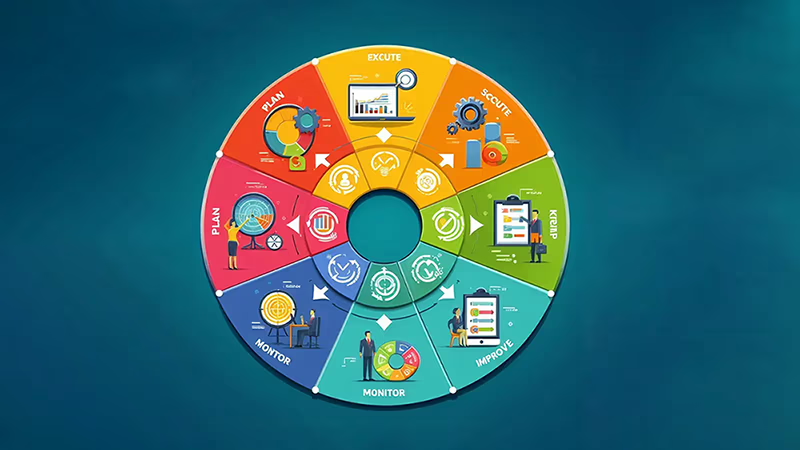In this Article:
- Introduction
- What is a KPI Culture?
- KPI Resistance, the fear of change
- Overcoming KPI Resistance
- Identifying the right KPIs
- Implementing the KPI Strategy
- Continuous Improvement and Feedback
Introduction
Imagine working daily, making wheel nuts with no purpose or value? How would you motivate yourself to produce a specific number or standard of nuts each day, without knowing how they fit into your organization's bigger picture?
Imagine you work for a motorsports team, and your wheel nuts are crucial for their success and safety. Every nut you make has to be flawless, with precise threads and casings. A tiny defect can mean the difference between life and death, victory and defeat, survival and bankruptcy.
Understanding that improving the design, the quality, and the processes around producing those nuts is part of an integral evolution that needs to be monitored, perfected, and understood. And to do this, you need a KPI culture.
Building a KPI culture in your organization is fundamental for achieving growth and achieving goals such as increasing market share.
A KPI culture is best described as one in which employees are clearly aware of the company's goals and objectives and have an unambiguous understanding of how their work contributes to these goals.
In this article, I'll discuss how to build a KPI culture. I will cover topics such as why KPI culture is essential, how to get buy-in from employees, how to set KPI goals, and how to use your KPIs to drive employee performance.
What is a KPI Culture?
A KPI culture is a business environment that emphasizes using key performance indicators (KPIs) to measure and improve performance. It also embraces those KPIs to track progress towards achieving goals and objectives. A KPI culture is one where those KPIs are used to drive decision-making, motivate employees, and improve overall performance.

A KPI culture embraces every aspect of the business process and makes it transparent for every company member to see how they affect the performance of the company's goal.
KPI Resistance, the fear of change
Resistance to change is nothing new to organizations aiming to grow; it is part of the evolution of all businesses. The reasons for resistance to adopting a KPI culture can be varied and complex, as employees yearn for stability and trust.

According to Stacey Barr, a performance measurement specialist, people may resist KPIs due to a lack of understanding, fear of change, or trust in the data. Additionally, people may resist KPIs if they perceive them as irrelevant to their work or if they feel that KPIs are being used to micromanage them.
Another reason for resistance to KPIs is that if they are clearly not aligned with the organization's goals or seem irrelevant, adoption can be unpredictable.
Before trying to dissolve people's resistance to KPIs, it is essential to listen to their concerns and understand their beliefs, attitudes, feelings, and ideas about performance measurement.
Overcoming KPI Resistance
Not every organization faces an organized rebellion to change. If correctly communicated, the path to a KPI culture can seem as natural as upgrading machinery or an IT (Information Technology) system. But there are some steps you can take that will encourage uptake and reduce the threat of an actual rebellion.

Here are some tips on overcoming resistance by employees to introducing a KPI culture in an organization:
Align your KPIs with your strategic goals.
The first and most crucial step in choosing KPIs is ensuring they align with your strategic goals and vision. KPIs should reflect what matters most to your business and help you track your progress toward achieving your desired outcomes.
Choose KPIs that are relevant, realistic, and measurable
The second step in choosing KPIs is to ensure they are relevant, realistic, and measurable. Relevant KPIs are specific to your business, industry, or function and capture the key aspects of your performance. Realistic KPIs are those that are achievable and attainable and that reflect your business's current state and capabilities. Measurable KPIs are those that can be quantified and tracked using data and metrics and that have clear definitions and formulas.
Select KPIs based on the realities of your organizational activity and environment.
The third step in choosing KPIs is to ensure they are based on the realities of your organizational activity and environment. Each organization operates in different environments, with different guiding principles. Hence, the KPIs you use need to reflect the specifics of your organization first and industry or functional area characteristics second. For example, if your organization is a nonprofit, you may need to use KPIs that measure your social impact, such as the number of beneficiaries served, the quality of life improvement, or the cost per outcome.
Provide adequate training and support for using and interpreting KPIs.
The fourth and final step in choosing KPIs is ensuring you provide adequate training and support for using and interpreting them. KPIs are only helpful if they are understood and used by the people who are responsible for them. Therefore, you need to provide adequate training and support for your employees to understand the KPIs' purpose, definition, calculation, and interpretation. You must also provide them with the tools and resources to access, analyze, and communicate the data and metrics effectively. For example, you can use a software solution like SimpleKPI to help you manage and monitor your KPIs in real time on Dashboards and Reports.
Identifying the right KPIs
Choosing the right KPIs for your business can be challenging, as there are many factors to consider, such as relevance, realism, measurability, and alignment. In this section, we will provide some tips on selecting KPIs that suit your business needs and goals.
Three Social Reach media KPIs:
- Impressions: This KPI measures the number of times your profile or a post has been seen on a social media channel. It does not distinguish how many unique accounts have viewed your content.
- Follower numbers: This KPI measures the number of people who have chosen to follow your account on a specific social media channel. It indicates how big and loyal your audience is.
- Audience growth rate: This KPI measures the percentage of change in your follower count over a period of time. It shows how fast your audience is growing or shrinking.
Implementing the KPI Strategy
Implementing a KPI strategy is not a one-time event but a continuous process that requires planning, execution, and evaluation. In this section, we will provide you with three steps for implementing a KPI strategy in your organization. Following these steps ensures that your KPIs are adequate, relevant, and meaningful for your business.

- Step 1: Set SMART targets for your KPIsDefine clear, realistic, and meaningful targets that align with your strategic goals and vision. For example, "Increase the NPS score from 70 to 80 by the end of the year".
- Step 2: Track and monitor your progress using data and metrics.Collect, analyze, and report the data and metrics that measure your performance against your targets. Use specialized software to access, visualize, and share your data and metrics in real time.
- Step 3: Communicate and celebrate your results with your team. Share the data and metrics that show your performance and progress with your team members, managers, and stakeholders. Provide feedback, recognition, and rewards to your team members who contribute to achieving the targets. Create a culture of learning and improvement, where you encourage your team to reflect on the successes, failures, and learnings from the KPIs, and to seek new ways to improve and grow. For example, use KPI Software such as SimpleKPI to communicate and celebrate your results with your team on KPI Dashboards, and to create a reward system that motivates them to achieve their targets.
Continuous Improvement and Feedback

Continuous improvement is essential for a KPI culture. It means you continually seek to improve your performance, processes, and goals. It is not a one-time event, but an ongoing process that involves reviewing and refining your KPIs, adapting to changing business needs and environments, and gathering employee feedback to improve your KPI culture. Essentially, this boils down to three main components:
Review and refine your KPIs periodically.
Update and adjust your KPIs according to your current situation and priorities. Evaluate their relevance, realism, and measurability and make changes as needed. Review your targets and benchmarks and ensure that they are still challenging, achievable, and aligned with your goals.
Adapt to changing business needs and environments.
Monitor and respond to the external and internal factors that affect your performance. Anticipate and prepare for future opportunities and threats, and adjust your KPIs accordingly. Communicate and explain the rationale behind any changes to your KPIs to your team and stakeholders, ensuring that they understand and support them.
Gather feedback from employees and use it to improve your KPI culture.
Solicit and listen to their opinions, suggestions, and concerns about your KPIs and culture change efforts. Involve them in defining, selecting, and reviewing your KPIs, and empower them to take ownership and responsibility for them. Recognize and reward their contributions and achievements, and provide them with constructive feedback, coaching, and mentoring.

by Stuart Kinsey
Stuart Kinsey writes on Key Performance Indicators, Dashboards, Marketing, and Business Strategy. He is a co-founder of SimpleKPI and has worked in creative and analytical services for over 25 years. He believes embracing KPIs and visualizing performance is essential for any organization to thrive and grow.
